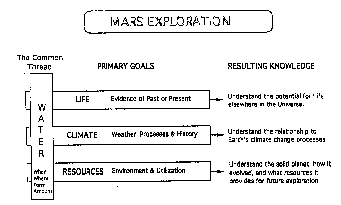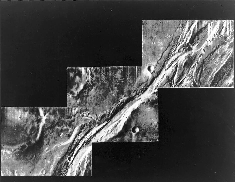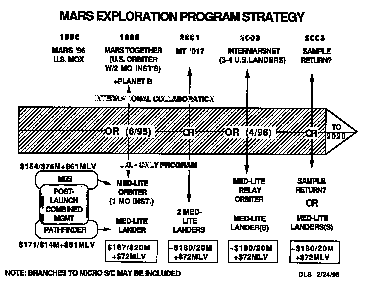

Water: The Common Thread of a Mars Exploration Strategy
Donna Shirley
The "Water Strategy"
NASA Administrator Dan Goldin and NASA Associate Administrator for Space
Science Wes Huntress have agreed on a strategy for the exploration of Mars
for the next 10 years. The strategy is to explore and study Mars in three
areas/
- Evidence of past or present life
- Climate (weather, processes and history)
- Resources (environment and utilization)
Each of these areas is connected with the search for water on Mars. When
and where was water present in the past, and what is its current form and
amount? We know from previous missions that the Martian polar caps include
water ice as well as frozen carbon dioxide. The Viking and Mariner 9 orbiter
images show evidence of past great floods (the Pathfinder lander is planning
to land in such an area), and of dry rivers and lake beds. Where did the
all the water go?
If life ever did arise on Mars it would almost surely have been connected
with water. And understanding the processes which led (or didn't lead!)
to life on Mars will help us understand the potential for life elsewhere
in the Universe.
Water is a key to climate, both on Earth and Mars, and understanding the
history of the Martian climate will help us better understand the Earth's
climate change processes.
Water will be a major resource for future human exploration of Mars, and
if we understand how the solid Mars evolved (including what happened to
produce water and make it disappear), we may be able to predict or find
reservoirs of water available for human use.

A Series of Missions to Build Up "Water" Knowledge
How do we go about finding out about water on Mars? Dan McCleese of JPL,
the Mars Exploration Program Scientist, and Steve Squyres of Cornell, the
head of the Mars Science Working Group, led that group to define a strategy
for the "water search." They looked at how small Mars orbiters,
landers, "networks" of landers, and sample returns could be combined
in a logical progression of missions that will build up an understanding
of how water existed and exists now on Mars.
The small orbiter missions will search for accessible water (we know that
ice is accessible at the poles, but are there reserves underground or in
the soil?). They will search for ancient sediments and hydrothermal deposits
(dry lake beds and geysers). They will provide data to understand the present
Mars climate and study how water escapes from the atmosphere into space.
The orbiters will also study the surface of Mars and identify good landing
sites for the landers, and will provide a radio link between the landers
and the Earth.
The small lander missions will search for carbonates and evaporites, minerals
that could only have formed in the presence of water. Landers can investigate
water reserves in detail/ for example they can measure the amount of water
that has been bonded to the soil, or drill into the polar ice caps to see
how many layers of snow have been built up. Investigation of surface chemistry
and how the rocks and soil have "weathered" due to water will
tell us about the past climate. And the landers may be able to find organic
compounds or even evidence that life may have been present at one time in
Mars' past.
"Networks" of more than a dozen very small landers scattered over
the planet could be used as weather stations to see how the Martian weather
changes over the whole planet and the whole Martian year. If the networked
landers have seismometers on board, and if they detect "marsquakes,"
that information will tell us about what Mars is like deep inside, and how
it might have evolved.
Finally, sample return missions can bring back rocks and soil for analysis
on Earth with very sensitive instruments (too large to take to Mars) which
can tell us about the climate history, the dates of different rocks, and
may even allow us to detect compounds that could have led to life, or which
are evidence of past life. (The odds of being able to select a rock with
a fossil, however, are very low, even if fossils exist on Mars.)
 Olympus Mons
Mosaic from Mariner 9. JPL-P-13074
Olympus Mons
Mosaic from Mariner 9. JPL-P-13074
A "Strawman" Mission Set
All of these missions must be done within the very tight cost constraints
of the Mars Exploration Program (about $100M per year). The Mars Science
Working Group laid out a "strawman" strategy for fitting the science
goals into a set of missions which can gradually build up our knowledge
of Mars over the next 10 years, following the themes of life, climate, and
resources.
First Mars Global Surveyor, which will orbit Mars from 1997 through 2002,
will study the surface of the planet and acquire information on the weather,
the magnetic and gravity fields, and the mineralogy. The 1997 landing of
Mars Pathfinder, with its stereo camera and rover, will send back to Earth
information on the geology and surface chemistry of a specific site.
Next, in 1998, another orbiter and lander (half the size and cost of Mars
Global Surveyor and Pathfinder) will be launched. The orbiter will carry
either a surface measuring instrument (the Gamma Ray Spectrometer - GRS)
or an atmospheric instrument (the Pressure Modulated Infrared Radiometer
- PMIRR), plus a small camera and a radio relay for the '98 lander. The
lander will carry the first of a series of lander payloads specifically
designed to carry out the "water strategy." The payloads will
be selected as total packages in a competition between science and engineering
teams. They may look for certain chemicals that give information on the
history and existence of water, they may analyze rocks to tell the history
of the climate, they may (if the lander is targeted to one of the poles),
drill into polar ice. In 2001 and 2003 there are opportunities to send additional
landers, which can continue to carry out the "water" investigations.
Any of these landers could be targeted to ancient lake beds to search for
"fossil slime." They could be sent to river valleys to investigate
how water once flowed on Mars. The landers could include rovers and/or sampling
arms to put instruments on the surface or retrieve samples for analysis.
In 2003 an alternative to sending more "large" landers would be
to send a network of meteorology/seismology stations, or a network of penetrators
that can make chemical measurements below the surface all over the planet.
And finally, in 2005, the Mars Science Working Group recommended that the
Mars Exploration Program attempt a Sample Return Mission - very challenging
within the cost constraint of about $200M!
An Augmented Mission Set
Even better opportunities for the "water strategy" will occur
if we can form teams with international partners. We are still exploring
the possibilities of "Mars Together " in 1998 with the Russians,
which would allow the U.S. to fly both the GRS and the PMIRR instruments
on the U.S. orbiter. This would let us study both the atmosphere and the
surface in a very complementary way starting in 1999. In 2003 the European
Space Agency (ESA) is proposing to send a joint ESA/U.S. mission to orbit
Mars and land three or four of the "large" U.S. landers, supported
with a radio link on a European orbiter.
And more instruments can be carried, or more landers sent, if new technology
improvements can be introduced into U.S. spacecraft to make them smaller,
lighter, and cheaper. A program called "New Millennium" is currently
being planned to develop and demonstrate a new generation of space technologies
to do this for both planetary and Earth missions. The Mars Exploration Program
will be a "customer" for this new technology, and some of the
New Millennium demonstrations may "piggyback" on Mars missions.

Return to Cover Page
 Olympus Mons
Mosaic from Mariner 9. JPL-P-13074
Olympus Mons
Mosaic from Mariner 9. JPL-P-13074

 Olympus Mons
Mosaic from Mariner 9. JPL-P-13074
Olympus Mons
Mosaic from Mariner 9. JPL-P-13074